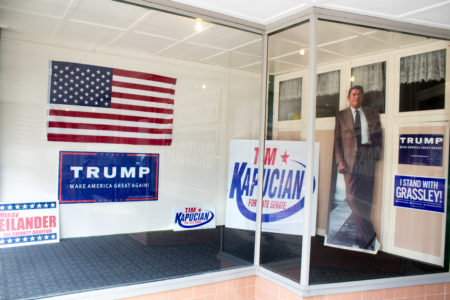
By Michael Cummings
cummings@grinnell.edu
For all the insanity of this 2016 Presidential Election cycle, Iowa at least has seen a respite for the past few months. After being flooded with candidates in the early months of the cycle leading up to Iowa’s first-in-the-nation caucuses, the state has been largely left alone since February. But this has started to change in the past month, as the Democratic and Republican National Conventions marked the transition from the primary season to the general election campaign.
Iowa’s status as a relatively “purple” state — one with a fairly balanced mix of Republican and Democratic voters — means that both major party tickets will be hitting the state hard in the months leading up to Election Day. The race in Iowa between businessman Donald Trump and former Secretary of State Hillary Clinton will be close by all accounts.
RealClearPolitics, a website which aggregates polls to put together election predictions, lists Iowa as one of eight toss-up states along with states such as Ohio, Missouri, Florida and Arizona. However, their current average of Iowa polls shows Clinton with a very slight lead — 42.0 percent with 40.5 percent for Trump.
Statistics blog FiveThirtyEight also projects an advantage for Clinton, with their polls-only model predicting as of Aug. 24 a 67.9 percent chance of Clinton carrying Iowa’s six electoral votes. However, the projected percentages of the vote that each candidate will win are much closer — in the range of 46 percent for Clinton to 43 percent for Trump.
It is clear that the candidates are taking the close race in Iowa very seriously. Clinton has visited Iowa once since securing the Democratic nomination, on Wednesday, Aug. 10 when she held a rally at Lincoln High School in Des Moines. Trump has also made several visits to the state since he secured his party’s nomination, including one stop in Des Moines on Aug. 5 and a swing through Eastern Iowa at the end of July.
The presidential candidates themselves aren’t the only ones campaigning in the state. Trump’s running mate Governor Mike Pence, R-IN, has campaigned in Iowa as well, hoping to use his status as a strong social conservative to win over Iowa’s large evangelical population. On the Democratic side, Senator Tim Kaine, D-VA, Clinton’s running mate, made headlines with a surprise visit to the Iowa State Fair, where he greeted voters accompanied by Secretary of Agriculture and former Iowa Governor Tom Vilsack.
While most media attention has gone to Clinton and Trump, several third party candidates running for President have also been focusing on Iowa. Libertarian Party nominee Gary Johnson, Green Party nominee Jill Stein and Independent Evan McMullin have all collected the requisite 1,500 signatures needed to get on the ballot in Iowa, as have candidates for the Constitution, New Independent, Socialism, Legal Marijuana Now and Liberation Parties.
Additionally, Stein, who has focused her campaign on winning over supporters of Senator Bernie Sanders (I-VT), plans to hold a rally on Sunday, Sept. 11 at the Iowa Capitol Building in Des Moines.
The Presidential Election is far from the only race affecting Iowans this cycle. Other notable races include long-time Republican Senator Chuck Grassley’s reelection bid, the race for the House of Representatives in Iowa’s First District, in which Grinnell is located and hotly contested State Senate and State House races across the state.
In the Senate race, Grassley is going up against former Lieutenant Governor Patty Judge, who is campaigning hard against Grassley’s refusal as Chair of the Senate Judiciary Committee to hold hearings on President Obama’s Supreme Court nominee. To this end, she has billed herself humorously to voters as “the one Judge Grassley can’t ignore.”
Grassley has easily won reelection every time since he first joined the Senate in 1981, and while his reelection seems likely, political ratings organization The Cook Political Report downgraded Grassley’s seat from “Solid R” to “Likely R” for this race, showing growing discontent among Iowans with Grassley’s actions in Congress.
In the race for Iowa’s First District House seat, incumbent Republican businessman Rod Blum, part of the Republican sweep of 2014, is up against former Cedar Rapids councilwoman and former candidate for Lieutenant Governor Monica Vernon. Blum is considered by many to be the most vulnerable Republican in Congress, considering the district’s Democratic tilt and concerns about a “Trump effect” harming Republicans down the ballot.
Vernon, who has been campaigning hard against Blum around the district, will visit Grinnell on Sunday, Aug. 28 at 5:30 p.m. in JRC 101. She will be accompanied by former Maryland Governor and former Democratic candidate for President Martin O’Malley.
In local elections, State Senator Tim Kapucian and State Representative David Maxwell, both of whose districts include Grinnell, are up for reelection. Both incumbents are Republicans, and they are being challenged by Democrats Dennis Mathahs and Jake Tornholm, respectively.
With all of these elections affecting the Grinnell community, campaigns are planning to hit the town hard in the coming months. The Republican Party has already opened a campaign office in Grinnell, complete with a cardboard cutout of Ronald Reagan, located downtown on Main Street. The Democratic Party has plans to open an office in the coming days on Fourth Avenue in the location previously occupied by the Pioneer Bookshop.
While this cycle has been plagued by unpredictability, one thing is for sure: candidates from all parties, up and down the ballot, are going to be all over Iowa in the coming months, leaving the state’s political vacation following the Caucuses far in the past.






















































